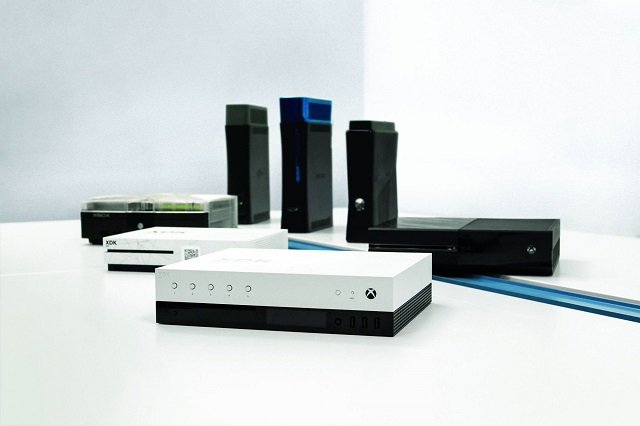The Xbox One originally released in late 2013 and is now seeing its first major upgrade, similar to the PlayStation 4 Pro system released last year, known for now as “Project Scorpio” — Gamasutra were able to get a first look and photos of the system’s brand-new developer kit. Today I’ll be breaking down all the juicy details and highlights from their coverage, starting things off with the actual specs of the development kit and retail models.
Notably the developer kits have a bit more juice under the hood outside of the CPU, featuring a GPU with 44 CUs (Compute Units) @1172 MHz (Megahertz) with a clock speed of 6.6 TFLOPS (Floating Point Operations Per Second) with 24GB GDDR5 RAM, a 1TB hard drive with an additional 1TB solid state hard drive and an optical disc drive with 4K UHD Blu-Ray support.
The retail model will have a GPU at 40 CUs @1172 MHz with a clock speed of 6.0 TFLOPS, with 12GB GDDR5 RAM, 1TB hard drive and will also have the 4K UHD Blu-Ray support and optical disc drive.
 Comparing this to the Xbox One, Xbox One S, and even the PlayStation 4 Pro — it’s a huge upgrade in terms of raw power on the GPU side of things.
Comparing this to the Xbox One, Xbox One S, and even the PlayStation 4 Pro — it’s a huge upgrade in terms of raw power on the GPU side of things.
For perspective PlayStation Pro’s GPU runs with 36 CUs @911MHz at a clock speed of roughly 4.12 TFLOPS. The Project Scorpio will also be boasting almost 50% more memory with its 12GB GDDR5 RAM @326GB/s compared to the PlayStation 4 Pro’s 8GB GDDR5 RAM @218GB/s.
Project Scorpio will also incorporate DX12 support, speaking with Gamasutra, Kevin Gammill (Microsoft’s group program manager for Xbox Core Platform) — had this to say,
“It’s the first time I’m aware of us ever doing something like this,” Gammill said. “We actually pulled some of the DX12 run time components directly into the hardware. So basically, these high-frequency DX12 draw calls you’d normally call [to output a frame, for example] which would take up a lot of GPU and CPU cycles, now that that’s baked into the system itself, it makes the system significantly more efficient.”
Developer feedback was also given on the previous hardware’s 8GB DDR3 ESRAM and was replaced entirely with 12GB GDDR5 RAM — speaking to Gamasutra,
“This was feedback we got from developers, that targeting ESRAM was harder, so we wanted to not make that an additional challenge,” he said. “The other thing we heard is that they wanted more headroom for their titles, so we moved from 5 gigs of RAM to 8.”

Microsoft will be shipping out developer kits of the Project Scorpio in the coming weeks, they’ll also be able to replicate both Xbox One and Xbox One S developer kits. The kit will feature a real-time clock and battery back up, an OLED screen with navigation buttons on the front of the box and five programmable buttons. (So for example if you’re working with a Project Scorpio developer kit, you’ll be able to set up the OLED screen to display useful information such as frame rate, GPU or CPU usage, etc.)
They’ll feature the same ports as the retail Project Scorpio, but with have three additional front-facing USB ports, an extra NIC (network interface card), and will also sport vents on the back and sides as opposed to the top, this way developers can conveniently stack multiple developer kits without having to worry about overheating issues.

Speaking to Gamasutra:
“I kid you not, I go to first-party studios, I go to third-party studios, and they have dev kits stacked. But they basically built blocks, or used Legos, as a gap so they could vent. Well now you can stack these 10 high.”
In closing with Gamasutra — Gammill had this to say:
“I want the best version of the games people want to play to be running on our platforms,” said Gammill, by way of explaining why Scorpio exists. “We didn’t have that until we came up with Scorpio. So Project Scorpio fills that gap.”
—-
Project Scorpio is set to release this holiday season, will you be picking one up? Let us know in the comments below and for everything Xbox related, stay tuned to GameSkinny.








Published: Apr 12, 2017 07:38 pm